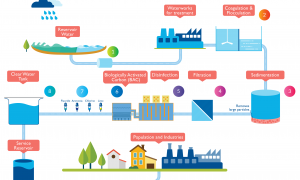🕑 Reading time: 1 minute
The design of canals using Kennedy's Silt theory is explained in the following sections. Added to that, assumptions regarding the suggested theory, its concept, limitations, and improvements will be presented.Contents:
What is Kennedy's Silt Theory?
RG Kennedy investigated canals systems for twenty years and come up with a Kennedy's silt theory. The theory says that, the silt carried by flowing water in a channel is kept in suspension by the eddy current rising to the surface. The vertical component of the eddy current tries to move sediment up whereas sediment weight tries to bring it down. Therefore, if adequate velocity available to create eddies so as to keep the sediment just in suspension silting will be prevented.
Fig.1: Eddies force according to Kennedy's silt theory
Assumptions regarding Kennedy’s Silt Theory
- The eddy current is generated because of friction between flowing water and the roughness of the canal bed.
- The quality of the suspended silt is proportional to bed width.
- The theory is applicable to those channels which are flowing through the bed consisting of sandy silt or same grade of silt.
Critical velocity based on Kennedy’s Silt Theory
Critical velocity is the mean velocity which will just make the channel free from silting and scouring. The velocity is based on the depth of the water in the channel. The general form of critical velocity is as follow:| Channel lining | N values |
| Earth | 0.0225 |
| Masonry | 0.02 |
| Concrete | 0.013 to 0.018 |

Fig.2: Depth of water in canal
Limitations of Kennedy’s Silt Theory
- Trial and error method used for the canal design using Kennedy’s Silt Theory.
- There is no equation for bed slope assessment, so the equation developed by Kutter used to compute bed slope.
- The ratio of channel width (B) to its depth (D) has no significance in Kennedy’s Silt Theory.
- There is not perfect definition for salt grade and salt charge.
- Complex phenomenon of silt transportation is not fully accounted and only critical velocity ratio (m) concept is considered sufficient.
Procedure of Canal design using Kennedy’s Silt Theory
There are two cases of canal design using Kennedy's Silt Theory dependent on the given data. Both cases presented below:Case 1
The following data shall be available before hand: discharge (Q), rugosity coefficient (N), Critical velocity ratio (m) and bed slope of the channel (s). 1. Assume suitable full supply depth (D). 2. Then, find the mean velocity by using Kennedy’s equation (Equation 3). 3. After that, find the area of cross section by using continuity equation: Where:
N: rugosity coefficient based on type of canal lining material. Table 2 provide N values for different lining condition.
S: bed slope as 1 in ‘n’.
Both the values of V computed using equation 3 and V computed employing equation 6 must be the same. Otherwise repeat the above procedure by assuming another value of D.
Generally, the trial depth is assumed between 1 m to 2 m. If the condition is not satisfied within this limit, then it may be assumed accordingly.
Table 2 N values based on the channel lining material
Where:
N: rugosity coefficient based on type of canal lining material. Table 2 provide N values for different lining condition.
S: bed slope as 1 in ‘n’.
Both the values of V computed using equation 3 and V computed employing equation 6 must be the same. Otherwise repeat the above procedure by assuming another value of D.
Generally, the trial depth is assumed between 1 m to 2 m. If the condition is not satisfied within this limit, then it may be assumed accordingly.
Table 2 N values based on the channel lining material
| Channel lining | N values |
| Earth | 0.0225 |
| Masonry | 0.02 |
| Concrete | 0.013 to 0.018 |


